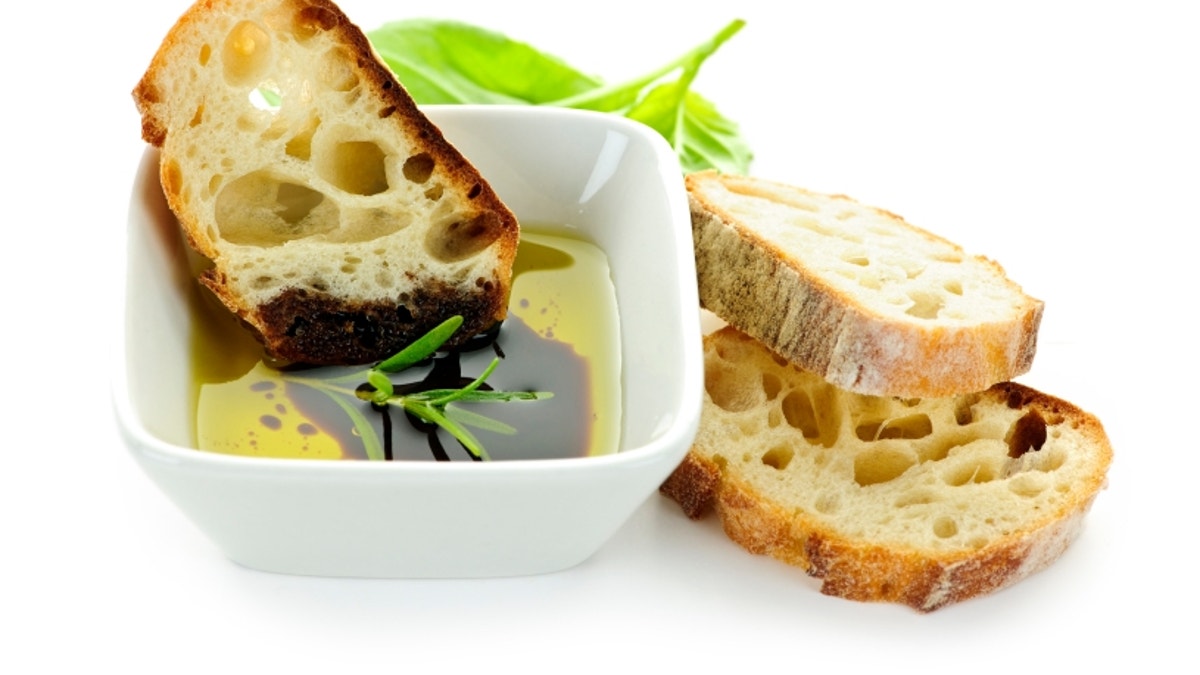
Italian food appetizer of bread olive oil and balsamic vinegar
In our quest to eat light, we know to pass up artery cloggers like fettuccine Alfredo; we regularly order sauce on the side and veggies instead of fries.
Problem is, "everything at a restaurant is 10 times more decadent than what you make at home," says Adam Roberts, author of Secrets of The Best Chefs. So even the healthy-seeming fare can pack surprisingly high calorie counts.
But that doesn't mean you have to eat at home every night (as if!). We grilled chefs and dietitians about the trends and dishes that can doom your stay-slim efforts. Commit these simple tips to memory and you'll never again fear a restaurant meal.
1. Don't OD on olive oil
You feel oh-so-virtuous dipping your bread in olive oil, but dunking can be a waistline wrecker. "It's still all fat and it's calorie dense, and bread soaks it up like a sponge," says Wendy Bazilian, author of The SuperFoods Rx Diet. Dip and devour two slices and you'll be at around 380 calories, or 75 percent to 90 percent of what most women should have for the whole meal. Butter is easier to keep track of (a thumbnail-size pat is about 45 calories), but it contains saturated fat.
Solution: Go with heart-healthy extra-virgin olive oil, but add balsamic vinegar to cut fat and calories and boost flavor, says Keri Gans, a registered dietitian and author of The Small Change Diet. Drizzle it on with a fork.
2. Beware 'small' plates
When tapas made their way to the States, they became super-sized—and, often, super-fried: An order of patatas bravas (fried potatoes with spicy mayo) weighs in at around 500 calories. Even lighter-seeming pesto shrimp and avocado crostini can run 640 calories per order.
"Plus, with tapas, most people don't feel full because they're not sitting down to an actual meal," Gans says. "Psychologically, they don't fill you up as much." Ditto the little plates at Mediterranean or Korean restaurants. They're all calorie bombs.
Solution: Look for the word grilled. And when ordering two appetizers instead of an entrée, make sure one is protein and one is veggies, so you feel satisfied and don't splurge on a third (less wholesome) mini dish.
__________________________________________________
More From Health.com:
25 Diet-Busting Foods You Should Never Eat
What Health Pros Order at Restaurants
27 Mistakes Healthy People Make
__________________________________________________
3. Don't trust the chef
You care about calories. We care about calories. That chef in the kitchen? Not so much.
"When I'm developing a menu, I think about what tastes good," says Missy Robbins, executive chef at A Voce restaurants in New York City. That's not to say she and other chefs use only high-cal, flavor-adding ingredients like cream and butter—they also use broths and herbs. But "the default method to make food taste better is to add more fat and salt," Roberts says.
Solution: Before ordering, ask, "Is there cream or butter in this dish?" Don't trust the menu description, because it rarely mentions the full prep.
4. Ask for plain veggies
Steamed veggies will never be a total disaster. (You're getting fiber and antioxidants, after all!) Still, top chefs often finish them in a sauté pan with a slick of butter or oil to amp up flavor, says chef Jonathan Rollo of Greenleaf Gourmet Chopshop, in Beverly Hills. The latest craze with veggies and salads is to toss them with bacon or bacon drippings... without mentioning it on the menu.
Solution: Order everything using the code word for un-fooled-around-with: dry. That way you can control your calorie count. And keep in mind that vegetables with a soft interior—eggplant and mushrooms—absorb more fat than root vegetables like sweet potatoes and parsnips.
5. Don't fall for looks
Gorgeously plated meals may look fabulous, but they can make you underestimate how much food is in front of you. A large serving suddenly looks teensy on a huge platter or piled up high. Starters like that Tex-Mex guilt trip known as Seven-Layer Bean Dip or desserts such as cobbler served in a Mason jar make it hard to figure out how much you're actually eating.
Solution: Do a proper-portion check. Lean protein should be no bigger than your smartphone; a serving of carbs should be the size of your fist, much smaller than the average pasta entrée. "Even if it doesn't say so on the menu, most restaurants will do any pasta entrée as an appetizer," Robbins says.
6. Say yes to steak
Red meat tends to get a bad rap, but when you order a lean cut, such as a filet or sirloin, it contains about the same calories as oily fish like tuna and salmon—especially when you consider portion size.
"A lot of times, you'll be served an 8-ounce portion of salmon and a 5-ounce portion of beef," says Jackie Newgent, registered dietitian and author of 1,000 Low-Calorie Recipes. "Calorie-wise, the beef is better."
Of course, the whole equation changes when either is served with even a little butter, oil, or sauce.
Solution: Ask the waiter to serve yours without. Better yet, request a side order of grilled lemon or lime for extra flavor.
7. Watch the salad
You know, of course, that cobb and Caesar salads can be fat traps. But mixed green salads can also do damage. One with goat cheese, pears, and candied walnuts, for instance, can set you back 500 calories.
Solution: Do as Victoria Beckham used to do when she dined at hotspot Angelini Osteria in Los Angeles: custom-create.
"She would suggest her own salad and order it with dressing on the side," says Ori Menashe, the restaurant's former chef and the current chef-owner of Bestia in Los Angeles. He and other chefs say you don't have to be an A-lister to make special orders—especially if you're just trying to have a healthier meal out.
